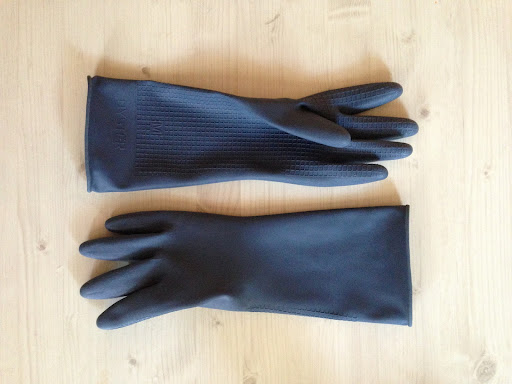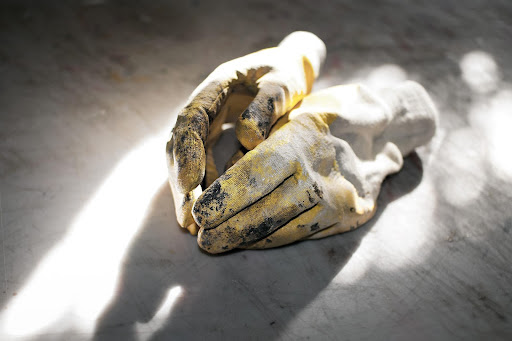Using the right work gloves is integral to your comfort and safety in the workplace. If you select gloves that don’t have the properties you need, you could be putting yourself at risk of avoidable injury.
This article will highlight the aspects you should look for in a pair of work gloves to protect your hands. As well as:
- Different types of gloves and their properties.
- Industries in which gloves should be used.
- The hazards you may encounter.
- Glove size.
- Specialised additions.
- Maximum Use Voltage.
Different types of gloves and their properties.
There are more types of gloves than just latex and latex-free. Wide varieties of gloves are available, made from different materials which provide them with properties that other types of gloves may not offer.
Not all gloves are suitable for all workplaces. It is important to weigh the benefits of each glove to ensure that you have exactly what you need to do your job safely and effectively.
- Nitrile Gloves
Nitrile gloves are best specialised for high-risk environments which handle corrosive substances.
Like all gloves, Nitrile gloves undergo a series of tests to ensure they are fit for distribution. These tests are called The European Standard, which tests a variety of properties to ensure that the gloves will withstand external forces.
Nitrile gloves are puncture-resistant and do not contain latex, which makes them durable and suitable for those with allergies.
- Vinyl Gloves
Vinyl gloves are most often used in low-risk environments, as they do not protect against corrosive materials and although puncture resistant, can break far easier than Nitrile.
They’re made using synthetic plastic polymers, which causes their production to be very fast and cheap. Vinyl gloves do not offer any specialised protection but do maintain a barrier between the hands of the wearer and external factors.
- Latex Gloves
Latex gloves are suitable for low-risk workplaces due to their water-resistant nature, puncture-resistant surface, and protection against potentially harmful bacteria. Additionally, natural latex gloves are biodegradable and take five years to decompose, which makes them far more environmentally friendly than other types of gloves.
However, latex is an allergen. So it will not be the best option for everyone. It is important to test yourself for latex allergies before purchasing latex gloves.
- Polythene Gloves
Polythene gloves are only intended for use in extremely low-risk environments, as they offer protection against nothing but dust, dirt, and dyes.
- Industrial Gloves
Industrial gloves are made from a combination of fabrics and rubbers to protect against various external forces such as electrical voltage, water, and sharp objects.
Industrial gloves are made normally with either Latex or Nitrile for water resistance and puncture protection.
Industries in which gloves should be used.
Protective gloves should be used in any industry where there is a risk to the health and safety of you or somebody else. That could be in the medical profession, food preparation, or even hairdressing.
The hazards you may encounter.
There are many hazards that your hands could encounter in the workplace. For example, you could use latex gloves to serve food but not realise that the customer could be allergic to latex, which could secrete onto the food.
But for those working in high-risk workplaces, by not wearing gloves, you could be putting yourself at risk of various injuries, such as:
- Electrocution.
- Penetration.
- Chemical Burns.
- Burns.
- Allergic reaction.
- Infections.
- Cuts.
Fortunately, injury can be avoided by wearing the correct gloves, but there’s more to it than simply knowing the qualities of different glove types.

Glove Size.
If your gloves are the wrong size, you could risk losing the dexterity needed to complete your job safely and effectively.
- If your gloves are too big:
Your motor performance may be hindered by your hands sliding around inside the gloves or if the fingers are too long, your hands may become trapped in tools or machinery.
- If your gloves are too small:
You could experience decreased blood flow to your fingertips which can cause unpredictable pain and hand fatigue.
Gloves should fit snugly (not tightly) and become looser over time. If they feel loose initially, you need a smaller size.
To determine your glove size, measure the palm of your hand. The circumference of your palm is your glove size.
Specialised Add-ons.
Perhaps the most important aspect of choosing the right glove for work is ensuring that you consider the kind of tasks you’ll be doing, and choose your glove additions accordingly.
Listed below are some features that would be beneficial for particular tasks to keep you safe.
- Abrasion Resistance.
Abrasion resistance is helpful for jobs like manual labour, as the harsh and rough materials on a work site, like brick, could wear your gloves down and make them unusable quite quickly without protection
- Chemical Resistance.
Chemical-resistant gloves protect your hands from corrosive chemicals which could give you chemical burns. Anyone who works with dangerous substances should use chemical-resistant gloves.
- Cut Resistance.
Cut resistance doesn’t mean indestructible. But cut-resistant gloves are designed to provide an extra layer of protection for your hands so that any sharp objects that you may come into contact with can’t reach your skin and cause injury. The Pawa Breathable Cut Level D Oil Gloves are a perfect example of cut-resistant gloves.
- Gripper Gloves.
Gripper Gloves allow the wearer to handle slippery objects far easier than an average glove. For example, factory workers who handle items all day would find gripper gloves useful because they’re less likely to drop and spill products.
Maximum Use Voltage.
Electrician gloves are tested using The European Standard for Maximum Use Voltage. If a pair of gloves specifies the Maximum Use Voltage, then they’re suitable to use with electrical items. They’re made with reinforced rubber, a material terrible for conducting electricity, so the wearer will not experience electrical shocks while working.
It is important to check the voltage of the item that you’re working on before purchasing any gloves.
Below are the classes that gloves can be categorised, and the maximum voltage they can withstand:
| Class 0 | 1000V |
| Class 1 | 7500V |
| Class 2 | 17,000V |
| Class 3 | 26,500V |
| Class 4 | 36,000V |











